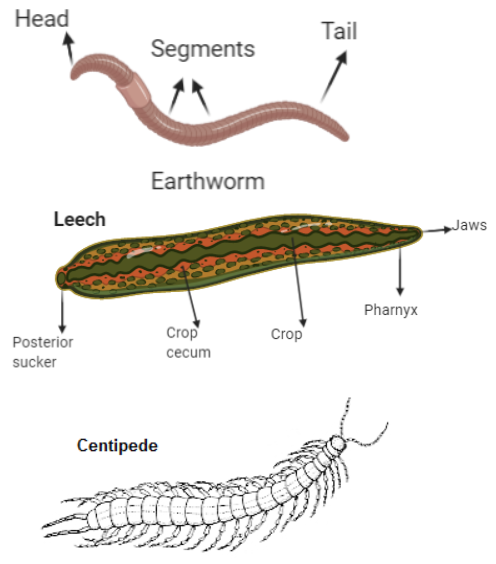
Which is common between earthworm, leech and centipede?
A. They have Malpighian tubules.
B. They are hermaphrodite.
C. They have a ventral nerve cord.
D. None of the above.
Answer
483.9k+ views
Hint: Earthworm and leech are annelids while centipede is arthropod. Arthropods and annelids have the same excretory system.
Step by step answer:
Earthworms and leech belong to the annelida class of animal kingdom. The species of this class have a unique identifying feature. The organisms have segmentation all over their body.

Some other characteristics of this class are:
1. Malpighian tubules are used by the organisms for excretion and osmoregulation. The Malpighian system consists of branching tubules that extend from the alimentary canal. They absorb water, solutes, and waste from the surrounding hemolymph.
2. They are generally hermaphrodite. This means that every organism of these classes has both male and female organs. This also includes other sexual characteristics. So, organisms of these classes do not differ in terms of sexes.
3. Organisms in this class have a ventral cord. Organisms of the Annelida class are invertebrates. They lack spinal cord. These organisms have a ventral nerve cord which functions similarly to the spinal cord in vertebrates.
4. They have sensory organs.
5. They are symmetrical.
6. They have coelom. Coelom means body cavity.
Centipede, on the other hand, belongs to the class Arthropoda.
Some characteristics of Arthropods are:
The class of Arthropoda has organisms that are gender-specific. This means there exist males and females. Arthropods use malpighian tubules for excretion. This helps them to conserve water. Arthropods are invertebrates. But phylum centipedes do not have a ventral nerve cord. They have a hard endoskeleton made of a compound called chitin. They have segmented bodies as well.
So option A is true.
Note: Malpighian tubules are located in the posterior regions organisms. They work in cooperation with glands in the rectum to excrete waste and maintain osmotic balance. Transportation of ions takes place through active pumps located in the malpighian tubules. The ions are secreted which results in water and waste drawn to the tubules. This is how water is conserved in these organisms making them adaptable to dry environments.
Step by step answer:
Earthworms and leech belong to the annelida class of animal kingdom. The species of this class have a unique identifying feature. The organisms have segmentation all over their body.

Some other characteristics of this class are:
1. Malpighian tubules are used by the organisms for excretion and osmoregulation. The Malpighian system consists of branching tubules that extend from the alimentary canal. They absorb water, solutes, and waste from the surrounding hemolymph.
2. They are generally hermaphrodite. This means that every organism of these classes has both male and female organs. This also includes other sexual characteristics. So, organisms of these classes do not differ in terms of sexes.
3. Organisms in this class have a ventral cord. Organisms of the Annelida class are invertebrates. They lack spinal cord. These organisms have a ventral nerve cord which functions similarly to the spinal cord in vertebrates.
4. They have sensory organs.
5. They are symmetrical.
6. They have coelom. Coelom means body cavity.
Centipede, on the other hand, belongs to the class Arthropoda.
Some characteristics of Arthropods are:
The class of Arthropoda has organisms that are gender-specific. This means there exist males and females. Arthropods use malpighian tubules for excretion. This helps them to conserve water. Arthropods are invertebrates. But phylum centipedes do not have a ventral nerve cord. They have a hard endoskeleton made of a compound called chitin. They have segmented bodies as well.
So option A is true.
Note: Malpighian tubules are located in the posterior regions organisms. They work in cooperation with glands in the rectum to excrete waste and maintain osmotic balance. Transportation of ions takes place through active pumps located in the malpighian tubules. The ions are secreted which results in water and waste drawn to the tubules. This is how water is conserved in these organisms making them adaptable to dry environments.
Recently Updated Pages
The correct geometry and hybridization for XeF4 are class 11 chemistry CBSE

Water softening by Clarks process uses ACalcium bicarbonate class 11 chemistry CBSE

With reference to graphite and diamond which of the class 11 chemistry CBSE

A certain household has consumed 250 units of energy class 11 physics CBSE

The lightest metal known is A beryllium B lithium C class 11 chemistry CBSE

What is the formula mass of the iodine molecule class 11 chemistry CBSE

Trending doubts
Give an example of a solid solution in which the solute class 11 chemistry CBSE

Describe the effects of the Second World War class 11 social science CBSE

Which of the following methods is suitable for preventing class 11 chemistry CBSE

Proton was discovered by A Thomson B Rutherford C Chadwick class 11 chemistry CBSE

How do you find the distance between two parallel lines class 11 maths CBSE

Why do you think did the narrator call lie Amsterdam class 11 english CBSE




